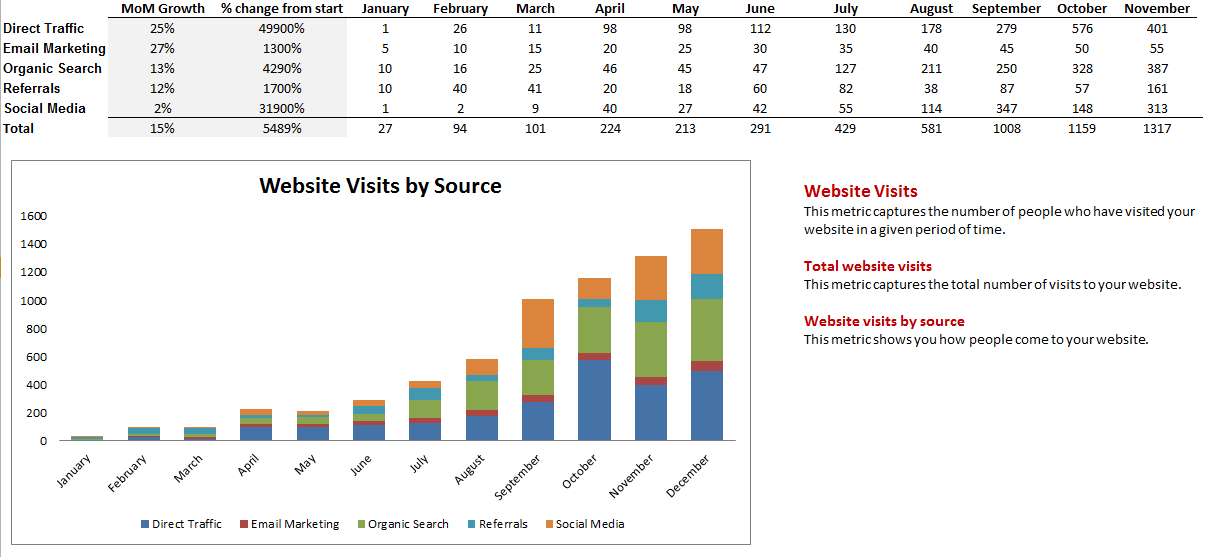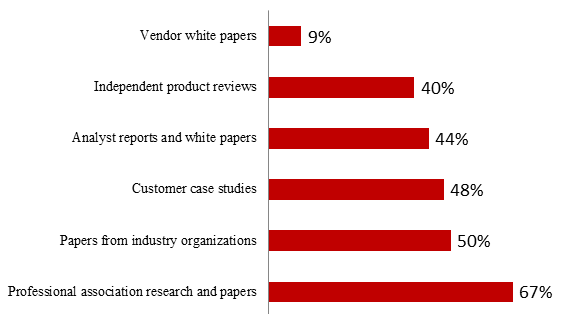
by Fronetics | Sep 2, 2014 | Blog, Content Marketing, Data/Analytics, Marketing, Supply Chain

To grow your B2B business you need to take a comprehensive data driven approach to marketing. Metrics enable you to measure success, drive strategy, and demonstrate the ROI of your marketing efforts.
What metrics should you track?
Given that your objective is to attract, acquire, and retain customers, the most effective metrics to track are those where the unit of focus is the prospect, lead, or customer. These include the following:
Visits
Visits capture the number of visitors to your company’s website in a given period of time. In addition to tracking the total number of visits, it is also important to track visits by source. That is, how visitors come to your website. Sources typically include direct traffic, organic search, referrals, social media, and email marketing.
Reach
Reach is the number of people who can be reached through your marketing channels (e.g. LinkedIn, Twitter, and Facebook). This metric is a good indicator of how well the content you are publishing attracts new people to your network, and how well the content engages people within your network. In addition to tracking your company’s total reach (the total number of people you can reach across all channels), you should also track reach by channel.
Leads
Leads are one of the strongest indicators of ROI. By tracking leads by source, you can identify where your marketing efforts are most effective, areas where you can improve, and areas you could eliminate from your strategy.
Customers
Customers are also a strong indicator of ROI. Like leads, customers should be tracked by source.
Conversion rates
Conversion rates measure the percentage of people who are moving from one marketing stage to the next. An increase in your conversion rates implies an improvement in the quality of your content and/or traffic. You should track the visit-to-lead conversion rate (How many of your website visitors are becoming new leads?) as well as the lead-to-customer conversion rate (Are you generating sales-ready leads?).
Ranking
Ranking matters. The top listing in Google’s organic search results receives 33 percent of the traffic compared to 18 percent in the second position. Two metrics you can track are your domain authority and your marketing grade.
Domain authority is a score ranging from 1 to 100 that represents how well a website will perform in a search engine ranking. The lower the score – the less likely it will be found. Marketing grade is a holistic measure of a site’s online presence as measured by HubSpot’s Marketing Grader on a scale of 0-100. A higher score is better.
How to track metrics for success
Having an established database to capture your marketing metrics is critical to success. We created a template that you can download and use to track your metrics, measure success, and drive strategy. One of the great features about this template is that it generates graphs that can be used in your reports and presentations.



by Fronetics | Aug 26, 2014 | Blog, Content Marketing, Marketing, Strategy

A 2013 survey of B2B marketers by LinkedIn found that when it comes to lead generation, customer testimonials and case studies are considered the two most effective content marketing tactics. Why are customer testimonials and case studies so effective? Because they are content that is valued and trusted by B2B buyers.
How can you write a B2B case study that generates leads?
Here are five elements of an effective case study.
- A case study is a story. Case studies that read like a story succeed. Case studies that are written, for example, as a sales pitch fall flat and fail to attract and engage prospective buyers.
- Case studies are not a sales pitch. Inform and educate through the sales pitch, but do not “sell.” An effective case study will generate new customers and sales.
- Prospective buyers turn to case studies for concrete examples. Make it easy for the reader to obtain the information desired. Bullet points, quotes, and lists are all examples of how you can deliver the highlights.
- Keep it short and sweet. A case study should provide the prospective buyer with enough information, but should not go into the minutia.
- Include these three components: the challenge, the solution, and the results.

by Fronetics | Aug 19, 2014 | Blog, Content Marketing, Leadership, Marketing, Strategy, Talent

By consistently creating, curating, and distributing valued and trusted content you can position your company as an industry leader.
What is valued and trusted content?
“Peer-power”
A survey by the CMO Council found that all content is not viewed equally by B2B buyers. “Peer-powered content” is more valued and trusted than non-peer content.
The survey found that professional association research and papers are the most valued and trusted content. Papers from industry organizations, case studies, and analyst reports and white papers were also reported to be valued. In contrast, vendor white papers were not found to be valued highly.
What type of content do you most value and trust?

Source: CMO Council
Depth not promotional
The characteristics that were found to be valued the most by B2B buyers were depth of the content (47 percent) and ease of access and readability (44 percent). Respondents reported that they do not like content that has too many requirements to download (50 percent) or is promotional or self-serving (43 percent).
Good content is shared
B2B buyers report that they share good content. Fifty-nine percent of survey respondents share content with 25 or more peers and associates, and 28 percent of survey respondents forward content on to 100 or more people.
Position yourself
To position your company as an industry leader you need to provide valued and trusted content. This means creating, curating, and distributing content that educates, informs, and addresses specific needs.
It also means avoiding the trap of self-promotion. Valued and trusted content is not content that is self-serving or promotional, rather valued and trusted content provides customers with answers, solutions, and education.
Blogging is essential, but additional content is necessary as well. Case studies and white papers are two go-to content solutions that can help you position your company as a trusted leader within your industry.
Remember that you don’t need to go it alone. More than 44 percent of B2B marketers report that they outsource content creation.

by Fronetics | Aug 19, 2014 | Blog, Content Marketing, Leadership, Marketing, Strategy, Talent

By consistently creating, curating, and distributing valued and trusted content you can position your company as an industry leader.
What is valued and trusted content?
“Peer-power”
A survey by the CMO Council found that all content is not viewed equally by B2B buyers. “Peer-powered content” is more valued and trusted than non-peer content.
The survey found that professional association research and papers are the most valued and trusted content. Papers from industry organizations, case studies, and analyst reports and white papers were also reported to be valued. In contrast, vendor white papers were not found to be valued highly.
What type of content do you most value and trust?

Source: CMO Council
Depth not promotional
The characteristics that were found to be valued the most by B2B buyers were depth of the content (47 percent) and ease of access and readability (44 percent). Respondents reported that they do not like content that has too many requirements to download (50 percent) or is promotional or self-serving (43 percent).
Good content is shared
B2B buyers report that they share good content. Fifty-nine percent of survey respondents share content with 25 or more peers and associates, and 28 percent of survey respondents forward content on to 100 or more people.
Position yourself
To position your company as an industry leader you need to provide valued and trusted content. This means creating, curating, and distributing content that educates, informs, and addresses specific needs.
It also means avoiding the trap of self-promotion. Valued and trusted content is not content that is self-serving or promotional, rather valued and trusted content provides customers with answers, solutions, and education.
Blogging is essential, but additional content is necessary as well. Case studies and white papers are two go-to content solutions that can help you position your company as a trusted leader within your industry.
Remember that you don’t need to go it alone. More than 44 percent of B2B marketers report that they outsource content creation.

by Fronetics | Aug 5, 2014 | Blog, Content Marketing, Marketing, Strategy

The amount of content on the internet is tremendous – and is growing by the second. With 93 percent of B2B companies using content marketing, and with more than $16.6 billion dollars being invested annually by B2B companies in digital content publishing – how can your content and your business stand out?
The CMO Council, Content ROI Center, and Netline conducted a survey of 352 senior-level B2B buyers, influencers, and decision makers with the objective of determining content’s role in influencing B2B buyers in the purchase process. The results of the survey can be used as a guide for creating content that will help you grow your business by driving profitable customer action.
Why do buyers consume content?
Sixty-two percent of B2B buyers turn to content in order to learn about new market developments and industry practices. Sixty percent turn to content to discover new solutions to address a specific problem. 52 percent look to content to address a project or a program being undertaken by their company.
Why do buyers value content?
Fifty-four percent of B2B buyers report they believe content keeps them current on new techniques. Forty percent say that it helps identify partners and solution providers. Thirty-eight percent of B2B buyers believe content provides strategic insights and shapes their purchase specifications. Thirty-seven percent of B2B buyers report that content educates them about industry issues, problems, and challenges.
Content that will grow your business
Content that will draw customers to your website and to your business is content that educates, informs, and addresses specific needs.
So that your business does not get lost in the clutter, you need to create and curate content that educates consumers about the industry, technology, and new market trends. Moreover, your content should address the needs and pain points of your target customer. Therefore, your content should answer questions, provide solutions, and provide strategic insight.
If you consistently create and curate content that B2B buyers find valuable, you will realize results.










